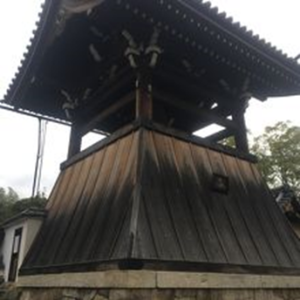Music is medicine, and metallic sounds are sounds used since ancient times to communicate with the heavens? ! <2>~Kyoto’s Ear Journey – What are Kyoto’s mysterious medicinal properties? ~
Yoshie Doi

Myoshinji temple bell
As Malraux said, “Culture is a device that creates human beings,” the nature that forms the source of Kyoto culture and the traditional industries that make the most of that nature have taken root in Kyoto’s lifestyle and have built Kyoto culture. The experiencing a life in Kyoto that draws on a thousand years of intellectual heritage is the ultimate cultural experience.
What’s more, the sounds that people would have heard during the Heian period can be heard in present-day Kyoto. The temple bell at Myoshinji Temple was the first to be built in Japan, dating back to 698 during the Nara period. It was said to have the power to alleviate the suffering of sentient beings suffering in hell.
Is this the reason why this metallic sound was used at the Gion Festival and has been passed down to this day? I don’t know for sure, but I know someone who lives in Tokyo and has been staying in Kyoto for the New Year’s holidays for over 20 years. Perhaps it’s because ringing the New Year’s Eve bell in Kyoto helps reset the mood.
It is reported that 32 temple bells cast during the Heian period remain in Kyoto. (Bonsho Research Institute) says that according to the Engishiki, these temple bells and drums informed the people of Kyoto of the time. It’s like a current time signal.
Sound has frequencies, and while some sounds soothe the body and mind, others make you feel uneasy. Mozart is said to have translated the sounds of nature into musical notes, but it seems that his musical scores were almost never altered.
If we walk around Hanamikoji in Kyoto, we can hear the sound of the shamisen, and if we go to Nishijin, we can hear the sound of looms. Although the number has decreased in recent years, we can still hear the sound and smell of red beans being cooked when we pass by a Japanese sweets shop. Unfortunately, we have heard that there are only 3 or 4 restaurants that cook their own red beans. I feel the times are changing.
Once, at the Kyo Suzume School, we performed gagaku for the late Hida kunitomi, the chief priest of Ichihime Shrine, at the site of Kaninnomiya’s mansion in Kyoto Gyoen National Garden. I was surprised when he told me, “You could buy a Mercedes Benz with just one of these,” but he ended by saying, “I’m sure the Prince will be very happy to be able to perform at Kan’in Shrine today.” ” was very impressive. It was at that moment that I realized that sounds can also be inherited.
It is said that by matching the frequency of nature, humans can coexist with nature as a member of nature, and that the sound of 432Hz (the frequency that makes people happy) can heal people.
Pianist Nobuyuki Tsujii plays and teaches the Steinway. Apparently he can only play Steinwein. Do you know the frequency?
The positive effects of Solfeggio frequencies on the mind and body became a hot topic when researcher Leonard G. Horowitz proposed them.
In particular, certain frequencies such as 528Hz are considered to be powerful love frequencies that promote DNA repair. Since the human body reliably resonates with the vibrations of sound, it is said that it is best if the vibrations of the Solfeggio frequency are constantly echoing in a physically nearby location. The sounds of Kyoto that are friendly to people will be heard from temples, shrines, and festivals. Sounds like a fun journey to find sounds.
The end of document
Translated by Masami Otani
